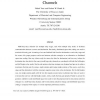119
Voted
VTC
2010
IEEE
14 years 11 months ago
2010
IEEE
—Recently, broadband analog network coding (ANC) was introduced to utilize high-data rate transmission over the wireless – frequency selective fading – channel. However, ANC ...
110
click to vote
TON
2010
14 years 11 months ago
2010
—One approach to prolong the lifetime of a wireless sensor network (WSN) is to deploy some relay nodes to communicate with the sensor nodes, other relay nodes, and the base stati...
107
click to vote
TMC
2010
14 years 11 months ago
2010
—A key challenge in the design of real-time wireless multimedia systems is the presence of fading coupled with strict delay constraints. A very effective answer to this problem i...
136
Voted
TCOM
2010
14 years 11 months ago
2010
Bidirectional relaying is a promising approach to improve the performance in wireless networks such as sensor, ad-hoc, and even cellular systems. Bidirectional relaying applies to...
117
click to vote
TCOM
2010
14 years 11 months ago
2010
—In a wireless network, the use of cooperation among nodes can significantly improve capacity and robustness to fading. Node cooperation can take many forms, including relaying ...
103
Voted
TCOM
2010
14 years 11 months ago
2010
— Mobile users with single antennas can still take advantage of spatial diversity through cooperative space-time encoded transmission. In this paper, we consider a scheme in whic...
117
Voted
INFOCOM
2010
IEEE
14 years 11 months ago
2010
IEEE
Abstract—With rising concerns on user privacy over the Internet, anonymous communication systems that hide the identity of a participant from its partner or third parties are hig...
91
Voted
CORR
2008
Springer
15 years 12 days ago
2008
Springer
Multi-hop relay channels use multiple relay stages, each with multiple relay nodes, to facilitate communication between a source and destination. Previously, distributed space-tim...
93
Voted
CORR
2010
Springer
15 years 12 days ago
2010
Springer
A Gaussian interference channel (IC) with a relay is considered. The relay is assumed to operate over an orthogonal band with respect to the underlying IC, and the overall system i...
90
Voted
CORR
2010
Springer
15 years 12 days ago
2010
Springer
We derive the capacity of the binary multi-way relay channel, in which multiple users exchange messages at a common rate through a relay. The capacity is achieved using a novel fun...





